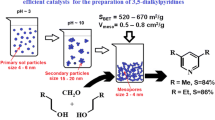Abstract
A salt of stearic acid, i.e., magnesium stearate [(C17H35COO)2Mg], can be used as a chemical template for the formation of mesoporous alumina, and is a less expensive reagent than stearic acid. Mesoporous alumina prepared using this cost-effective surfactant shows similar pore properties with respect to pore size (3.5 nm) and surface area (above 300 m2Vg) to that prepared using stearic acid. In addition, textural porosity, arising from non-crystalline intraaggregate voids and spaces, was effectively removed by the addition of magnesium nitrate. The entire transformation from aluminum hydroxide to active alumina was performed at 550 °C, and the crystallinity of the product was confirmed by powder XRD analysis.27A1 MAS NMR result shows the phase of mesoporous alumina is the γ-alumina form.
Similar content being viewed by others
References
Bagshaw, S. A. and Pinnavaia, T. J., “Mesoporous Alumina Molecular Sieves,”Angew. Chem. Int. Ed. Engl,35, 1102 (1996).
Digne, M., Sautet, P., Raybaud, P., Toulhoat, H. and Artacho, E., “Structure and Stability of Aluminum Hydroxide: A Theoretical Study,”J. Phys. Chem. B,106, 5155 (2002).
Kim, Y., Lee, B. and Yi, J., “Synthesis of Mesoporous γ-Alumina through Preand Post-hydrolysis Methods,”Korean J. Chem. Eng.,19, 908 (2002).
Kim, Y., Kim, P., Kim, C. and Yi, J., “A Novel Method for Synthesis of a Ni/Al2O3 Catalyst with a Mesoporous Structure using Stearic Acid Salts,”J. Mater. Chem.,13 (2003)
Krokidis, X., Raybaud, P., Gobichon, A.-E., Rebours, B., Euzen, R. and Toulhoat, H., “Theoretical Study of the Dehydration Process of Boehmite to γ-Alumina,”J. Phy. Chem. B,105,5121 (2001).
Schüth, F., “Non-silicious Mesostructured and Mesoporous Materials,”Chem. Mater.,13, 3184 (1996).
Sohlberg, K., Pennycook, S. J. and Pantelides, S. T, “Hydrogen and the Structure of the Transition Aluminas,”J. Am. Chem. Soc,121,7493 (1999).
Vaudry, F., Kohdabandeh, S. and Davis, M. E., “Synthesis of Pure Aluminas Mesoporous Materials,”Chem. Mater,8, 1451 (1996).
Wolverton, C. and Hass, K.C., “Phase Stability and Structure of Spinelbased Transition Aluminas,”Phys. Rev. B,63, 024102 (2000).
Yada, M., Machida, M. and Kijima, T., “Synthesis and Deorganization of an Aluminum-based Dodecyl Sulfate Mesophase with a Hexagonal Structure,”Chem. Commun., 769 (1996).
Author information
Authors and Affiliations
Corresponding author
Rights and permissions
About this article
Cite this article
Kim, C., Kim, Y., Kim, P. et al. Synthesis of mesoporous alumina by using a cost-effective template. Korean J. Chem. Eng. 20, 1142–1144 (2003). https://doi.org/10.1007/BF02706951
Received:
Accepted:
Issue Date:
DOI: https://doi.org/10.1007/BF02706951



